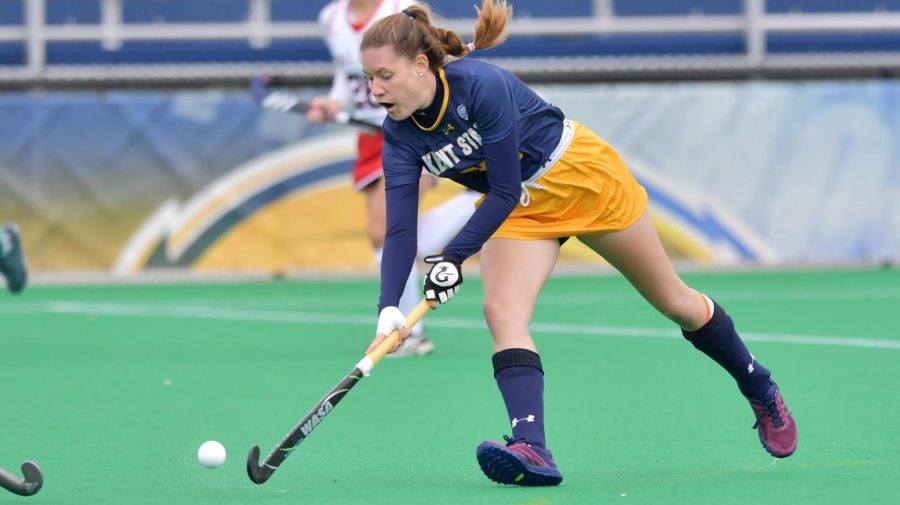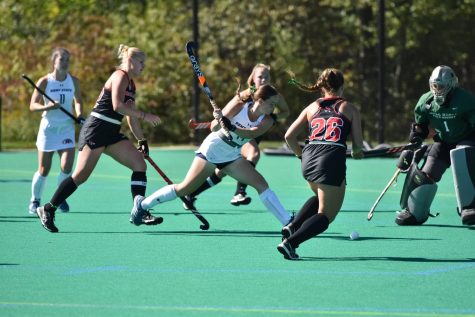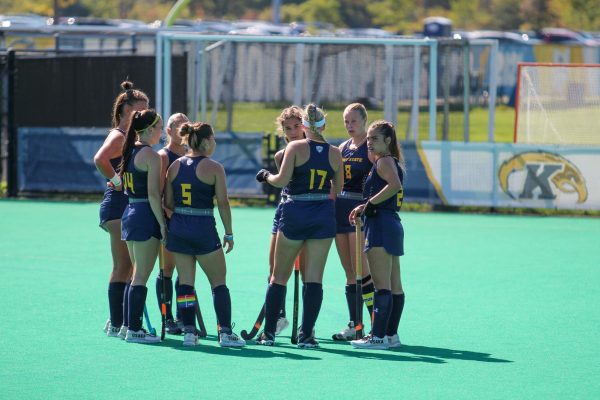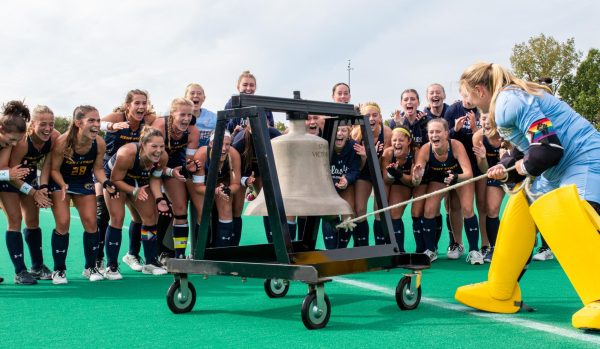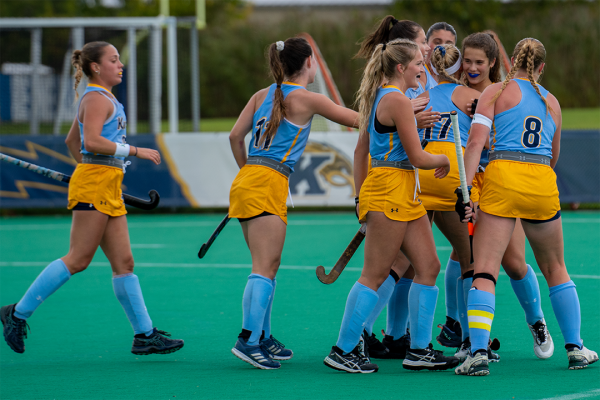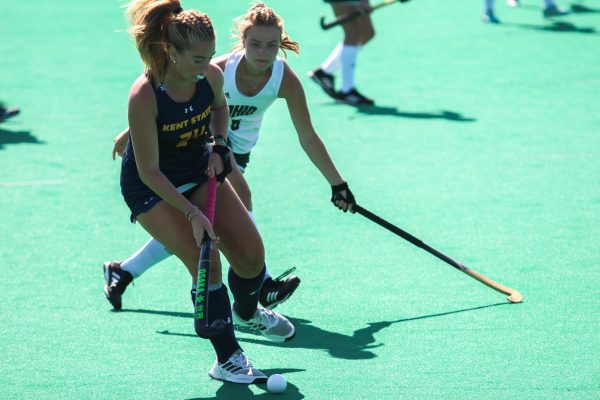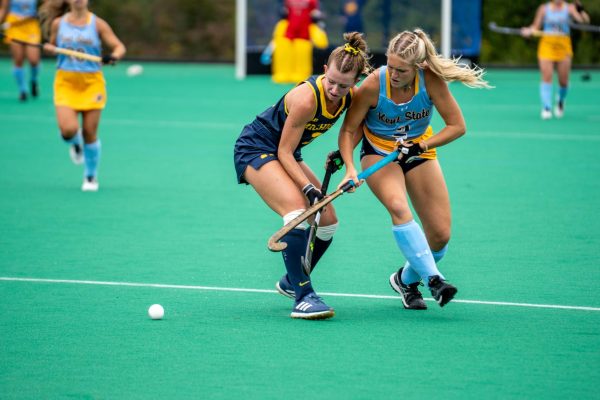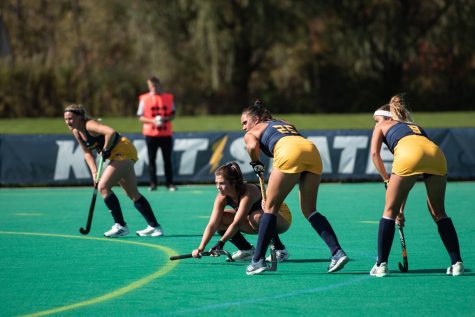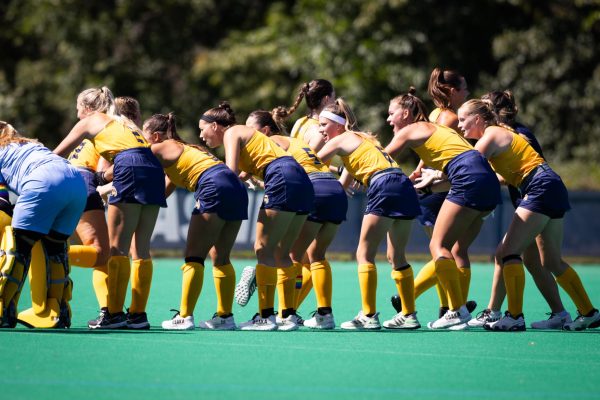Coming to America: How Kent State field hockey has created an international atmosphere
December 15, 2021
Freshman Jersey Hasenbos had graduated from high school in the Netherlands before she had even heard of Kent State or thought about playing field hockey in the United States.
Now she’s an up-and-coming midfielder for the Flashes.
Hasenbos is one of 11 international players on the 26-member Kent State’s field hockey team All have similar yet unique stories of their journeys to America and their adaptation to college life in America.
Finding a team in America
Teams in all sports recruit American athletes in person. But when finding athletes from other countries, coaches like coach Kyle DeSandes-Moyer use recruiting agencies.
“There is a huge business of recruiting agencies,” DeSandes-Moyer said. “There are thousands of them that exist all over the world in all different sports across the NCAA.”
“Sometimes they reach out to us, sometimes we use pre-established relationships with those agencies. As well as pre-COVID, traveling to their countries and watching them play.”
Hasenbos had heard about studying abroad early in high school, and one of her friends had been an exchange student. But Hasenbos had decided that it wasn’t for her until an unexpected message in May 2020.
“I got a DM on Instagram from one of the different companies that saw I was playing field hockey,” Hasenbos said. “I signed in to one of the companies, and I looked more into it. I didn’t know you could play field hockey and study abroad until then.”
The COVID-19 epidemic made the process more complicated for Hasenbos, who is from Amstelveen, the Netherlands.
“Normally, the coaches come to our countries and watch us play and practice,” Hasenbos said. “We couldn’t do that due to COVID, so the recruiting video was all I had. But at the same time, if your video wasn’t good, then it sucked.”
COVID also meant Hasenbos didn’t get to play any games during 2020 in the Netherlands.
“Our material and footage of me playing was mostly of the year before that,” she said. “I also had to do some stick skills on the field [on video], so it was a little bit harder.”
In many countries, collegiate sports don’t exist. If players want to compete after high school, they typically would play for a club. The idea of sports in the United States for various different colleges was different for Hasenbos.
“It was so overwhelming for me; I had a lot of Zoom meetings and all that stuff with different schools,” she said. “A lot was so overwhelming.”
“I didn’t know what Division I or Division II were. So I had to be taught what those were, and Kent State was the only one where I really liked the coaches and the feeling of the community.”
Senior forward Luisa Knapp, who is from Bietigheim-Bissingen, Germany, reached out to an organization that helped German players find schools in the United States.
“They set up a profile, helped with the ACT, the English tests, and the paperwork,” Knapp said. “They helped me make a highlight video. Whoever was interested would reach back out to me, and I used Skype or phone calls.”
Coming to America
Once recruiting agencies sent highlight videos, the coaches would reach out to the players.
“We all worked with a company, then coaches reached out to us,” Hasenbos said. “I had a lot of Zoom meetings and all that stuff with different schools.”
Once they’ve committed, they start to hear from their new teammates.
“First we usually add each other on Instagram and then we use WhatsApp,” said fifth-year midfielder Ashley Bonetz, a senior from Douglassville, Pennsylvania. “I really utilize Instagram DMs, which is what I used for Clara.”
“Clara” Rodriguez Seto is a fifth-year midfielder from Barcelona, Spain. She and Bonetz became good friends in their years playing together.
“At first it was a little hard for [Rodriguez Seto] to talk,” Bonetz said. “She was fluent, but it is just hard with some of the humor. Now Clara understands. To see the way she is now versus when she started is like a complete transition. Now she is my best friend, and I am going to see her family in Spain. It is going to be really cool.”
Rodriguez Seto, who was the team’s leading scorer this season, chose Kent State after talking with one of the players on an international call.
“There was a girl a year older than me from Spain, and I got to talk to her,” Rodriguez said. “It was the only team that offered me to talk to one of their players. She told me that she loved it, the team was super nice, she was having so much fun, and it was such a great experience. [Kent State] was the first one to offer me a scholarship.”
Rodriguez flew in with her family and was met at the airport. They came with her and stayed at a hotel. But shortly she discovered her transcripts hadn’t arrived in Kent.
“It was nice to have them there,” Rodriguez Seto said. “Because I was not eligible, I had to miss my first game.”
After COVID-19 hit, sophomore back Alex Sacker flew on her own from Turnbridge Wells, England.
Alex and other international students were quarantined off-campus during the chaos.
“For me it was different because I came over during COVID,” Sacker said. “So I literally came over on my own, and stayed in Clara’s house and had to wait and see what was going on with the season.”
At the airport
Kent State has current team members pick international players up at the airport, so they would get to know each other quickly.
“This was the first time I saw my teammates,” Hasenbos said. “When I met them, I felt safe. Everyone was so helpful, and I felt like it was a good environment.”
Hasenbros discovered her suitcases were lost on the trip.
“I haven’t slept for like 24 hours, and it was a little overwhelming,” Hasenbos said. “I was like, ‘Why did I do this? All my friends were safe at home studying. Why am I so crazy living on the other side of the world?’
“But my teammates showed me what to do about the suitcase. Everyone was so nice, and I was like, ‘This is good.’”
Freshman midfielder Agustina Florio from Buenos Aires, Argentina, ended up in quarantine with two of her new teammates.
“I had to quarantine for a week, so I got to spend a week in Luisa’s and Alex’s house and got to know them,” Florio said. “They helped me with everything, like paper work, and the beds in dorms, and it was really nice.”
Players often lived with the new teammates before moving into the residence halls.
“When I first came, a senior let me stay in her house for the first couple of days,” Knapp said. “My teammates all were helping with small stuff — like checking in how we were doing, asking if I needed anything, or if I talked to my parents, and just showing that they cared.”
The team wanted to learn about her country and experiences.
“They would say, ‘You can just drive eight hours and be in a different country,’ Knapp said, “and here, you can drive eight hours and only make it to another state.”
Learning the American ways
“Everyone asks questions. We’d ask how it is to live in Ohio versus living in California,” Knapp said. “And they will ask us how it is to live in the Netherlands compared to Germany.”
Parents of American players also helped out the new international players.
“One day, one of the parents asked me if I had anything for my dorm like bedding, pillows, towels, and I said, ‘Yeah, no,’” Knapp said. “So they took me shopping.”
Speaking American
“Most people from other countries learn English from a very young age,” DeSandes-Moyer said. “In fact a lot of our international athletes speak multiple different languages.”
Rodriguez Seto said she had started studying English when she was 5 years old.
“We have nationwide exams, and everyone has to take the same exam to get into college, and one of the exams is an English exam,” she said. “I didn’t have the same level I have now, but I was able to speak English.”
“I might say something different than what they say, then I would just talk to someone from Spain to understand, so we understood each other pretty well.”
Field hockey, U.S. style
On the field, the style of play was different than Rodriguez Seto was used to back home.
“It was very physical,” she said. “There is a lot of conditioning and running. At home, we would use our skills more and pass the ball around and didn’t run as much.”
Sacker had to get used to a new formation.
“We use three backs, four midfielders, and three strikers,” Sacker said. “At home, we would use two backs, almost four midfielders, two inside and two strikers. It isn’t a bad difference, it is just different.”
The American life
Outside of field hockey, the women felt welcomed into American life.
Florio got to meet people through other sports teams.
“We would share a room with the women’s lacrosse team,” she said. “So we got to meet a bunch of friends that way.”
The players try to take advantage of the free time they get.
“I like to call my friends and my family,” she said. “Or maybe use my free time to watch a show from Argentina, and to sleep or take a nap.”
Sacker said she loves the opportunities you have on campus and the support from the university.
“I have an older sister who went to uni in the UK, there are a lot more opportunities and support here,” she said. “She sailed for the university and got no funding, treatment, or rehab from the school to help her out.”
Finding food can be a challenge.
“The food in the dining halls are a lot greasier and fried than I’m used to,” Sacker said. “Sometimes I just want a healthy dish, which can be hard.”
The players have found the campus to be kind.
“People are so nice here,” Hasenbos said. “When I’m walking around, people will say, ‘I like your shoes,’ or say, ‘Hi, how are you?’ That is something you would never do in my country. If you passed someone in the streets, they wouldn’t even say hi.”
Jacob Hansen is a reporter. Contact him at Contact him at [email protected].


